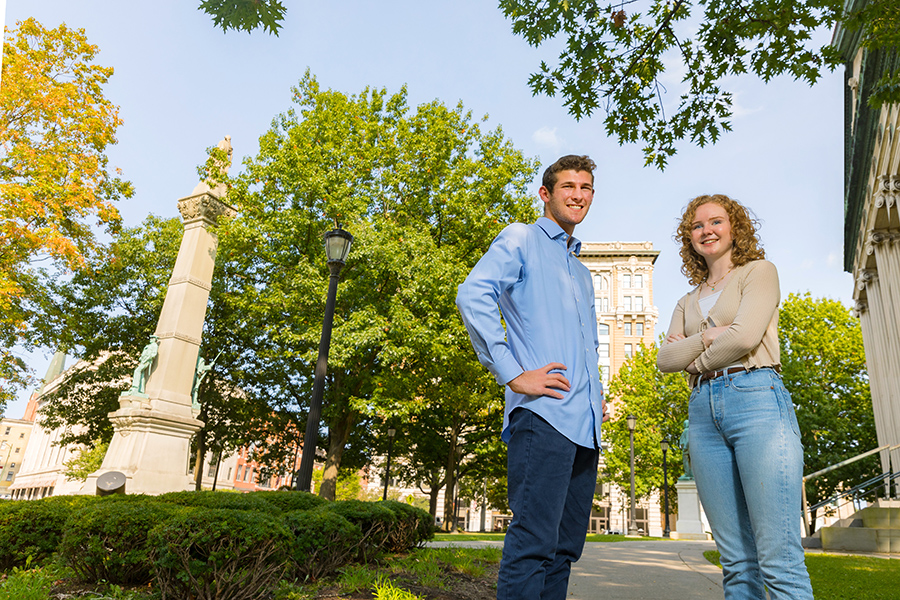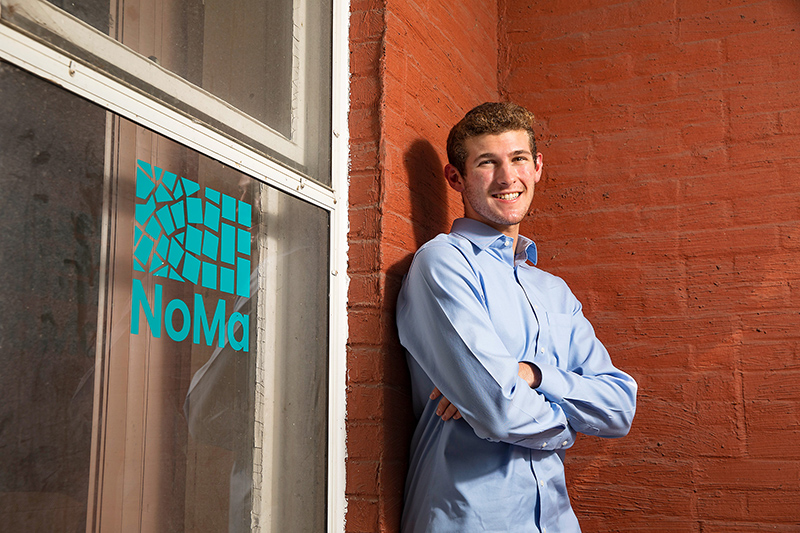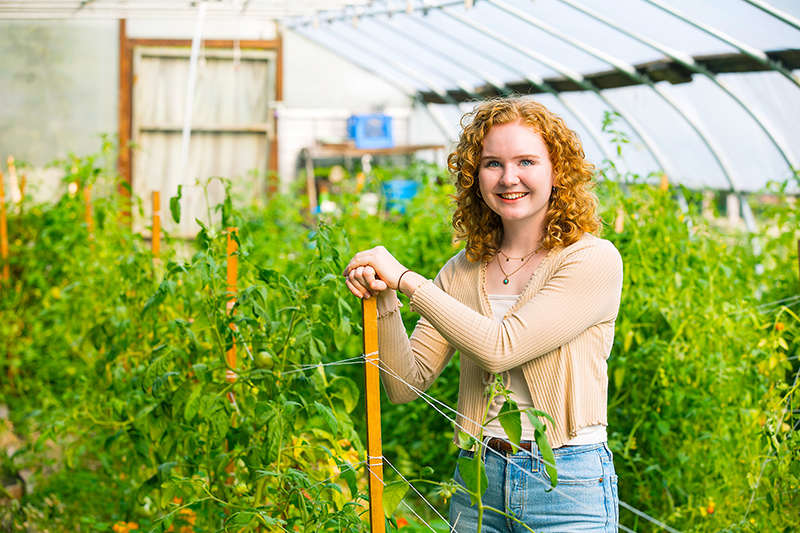University, community help develop student LEADers
Center for Civic Engagement program combines local service with on-campus workshops

Brandy Brown knew she had a special student volunteer in Ethan Shulman when he started arriving at the NoMa (North of Main) offices in Binghamton before she did.
“He was so helpful. Anything I’d ask him to do, he would do it,” says Brown, the community center coordinator for NoMa, which works with local partners to maintain Binghamton’s West Side. “I was amazed by Ethan’s cooperation. Nothing was too big or too small for him.”
Shulman, now a second-year accounting major in the School of Management, spent time at NoMa in the spring 2021 semester as part of the Binghamton University Center for Civic Engagement’s (CCE) Leaders in Engagement, Advocacy and Democracy program (LEAD).
The program, which launched in fall 2019, enables students to develop skills to succeed as community leaders by participating in community service, weekly seminars, and individual and group reflection.
CCE Director Kelli Huth says she hopes students in the LEAD program will feel a “deeper sense of belonging in the Greater Binghamton area” and integrate community engagement into their educational and career pathways.
“By building relationships with our neighbors and organizational partners, exploring community strengths and assets, and collaboratively addressing challenges faced by people with diverse backgrounds, students can develop the skills and empathy necessary to become dynamic leaders and valuable community advocates,” she says. “Ideally, this program will result in tangible benefits for our community partners and unleash additional potential for students to learn, reflect and excel beyond the boundaries of our campus.”
The requirements
Any Binghamton student can apply to participate in the LEAD program. But a curiosity about community service helps, says CCE Associate Director Alison Handy Twang ’11, MPA ’13, who oversees the program.
“We try to target students who are already doing community service in some way, but are interested in bringing that service to the next level,” she says.
Selected students then work with Twang and others in the CCE to:
• complete two to five hours of community service per week with a community organization,
• participate in weekly workshops with the other program members and
• make an end-of-the-semester presentation about the experience.
Students do not receive academic credit for completing the program. Instead, they earn a microcredential demonstrating competency in civic and community engagement, critical thinking/problem solving, professionalism and career management. Students also get a digital badge that can be displayed on their LinkedIn page.
The LEAD program works with students to find the right community partner. Usually it is an organization in Binghamton, but it can also be a community group that the student is already connected with, Twang says.
LEAD has a network of community partners in place, including NoMa. Located on Walnut Street in Binghamton, NoMa has a connection with Binghamton University, thanks to alumni and faculty members serving in the organization.
“NoMa is a natural fit for us because it has a history and experience of working with students — not just through LEAD, but through the Hinman Public Service Learning Community and different student organizations,” Twang says.
Student stories
Shulman and his family in Chicago had taken part in several service projects over the years, so he was hopeful of filling some free time on Mondays, Wednesdays and Fridays in the Binghamton community.
“I saw LEAD on the CCE website and thought it would be a good fit,” he says. “I wanted to get involved in the community, but didn’t know how.” Shulman was placed with NoMa and did a variety of work there, ranging from preparing and running weekly clothes drives to handing out event fliers to organizing a pandemic personal hygiene drive to helping at the organization’s Family Fun Day.
“When we first talked with him, he seemed so shy,” Brown recalls. “But he is loving and caring.
He was so engaged with the children at Family Fun Day. … To have Binghamton students helping us is amazing.”
Allison Underhill, a third-year student from Clifton Park, N.Y., made a difference outside the area during her LEAD time. She worked with the U.S. Committee for Refugees and Immigrants in Albany, serving as an English as a Second Language tutor through Zoom for an Afghan woman living near Underhill’s hometown.
Like Shulman, Underhill grew up with community service as a part of family life, volunteering in soup kitchens since the third grade.
“Connecting with the community and people on a more personal and humanitarian level centers myself more than schoolwork,” says Underhill, a double major in human development and Spanish. “I get a lot of value from my coursework, but I’m not seeing the firsthand practicality as a [classroom] student.”
One of Underhill’s memorable LEAD experiences was using the Macarena and its steps to teach the refugee about the months of the year.
“I felt like a fool in my room, just dancing around and singing the months of the year,” she says. “My roommates thought I was crazy. But in the end, both [the refugee and I] were laughing. I don’t know how much she understood, but there was a human connection through language, dance and song.”
Both Underhill and Shulman praised the workshops (which emphasize things such as diversity, equity and inclusion, and connecting service to professional development) and reflection components of the LEAD program.
“They are great tools to go with the community service,” Shulman says. “The weekly connections we made helped us talk honestly about what was going on [in our work].”
What’s next
Although the pandemic interrupted the program in fall 2020, Twang believes that LEAD is ready to support even more students in their civic engagement journeys. The program has averaged six to 10 students per semester, but Twang says she can envision up to 15 students taking part each semester. LEAD could even expand to include community partners in Johnson City (home of the Health Sciences Campus) and Endicott.
“Maybe this will inspire students to take on new opportunities and approach their work in a different way,” Twang says. “They can think of themselves as part of this community and as civic leaders here in Binghamton and when they graduate. The broader goal is creating a culture of engagement at Binghamton.”
The program has already succeeded in creating young community leaders such as Shulman and Underhill. Shulman is spending the fall semester as an intern for the Gift of Life Marrow Registry, tabling at events and getting people to join the public bone marrow and blood stem cell registry.
“Without LEAD and working with NoMa, I don’t think I would’ve applied [at Gift of Life] or realized the difference I could make there,” he says.
Underhill, meanwhile, is scheduled to graduate in spring 2022. But she is considering pushing graduate school back a year to work as a “public servant” in Binghamton and get more “on-the-ground” experience before pursuing a Master of Public Administration degree. She is working this fall with VINES, a Binghamton organization committed to developing a sustainable and inclusive community food system.
“I spent the summer [of 2021] in Binghamton,” she says. “It’s such a strong community with potential. I’d like to explore it some more.”
The LEAD program, Underhill says, helps provide a foundation for the exploration.
“Getting students involved in something greater than themselves and their futures is imperative for us as people, along with the bonds between the community and the school,” she adds. “That’s huge.”


